Missing Granny the Whale
Air Date: Week of January 13, 2017
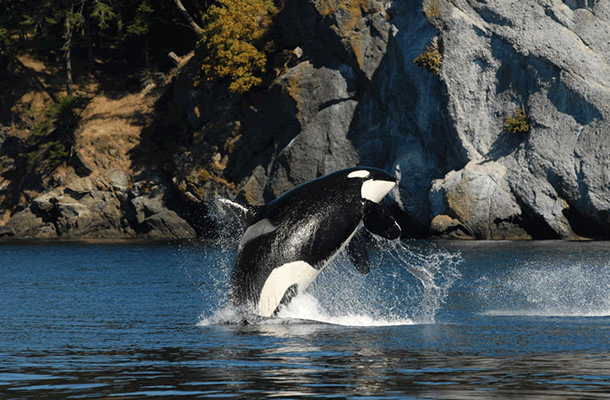
J2, also known as “Granny”, may have been as old as 105 at her death. (Photo: Center for Whale Research)
They called her “Granny”, the matriarch of an orca pod in Puget Sound. Ken Balcomb, founder of the Center for Whale Research, has studied Granny, officially named J2, for more than four decades. Granny might have been as old as 105 and she led her pod to find salmon, their major food source. She’s presumed dead as she has not been seen for over 3 months. Ken Balcomb tells host Steve Curwood, the J-pod, already impacted by rising toxicity in the ocean food chain and depleted salmon stocks, may now fragment.
Transcript
CURWOOD: It’s Living on Earth, I’m Steve Curwood. Orcas, or Killer whales are the largest of the dolphin family, and two of the most famous of these whales recently died. Tilikum of SeaWorld starred in the documentary Black Fish and became a poster-creature for the problems of confining Orcas in tanks to perform for audiences. And, by the way, other Orcas at Sea World in San Diego will no longer perform, though they will still live at the park.
And in Puget Sound off Seattle a wild Orca nicknamed “Granny”, is presumed dead, and she may have been 105 years old. Researchers knew her as J2 and say she was the oldest known killer whale until she went missing about three months ago. Ken Balcomb will miss this matriarch cetacean more than most.
He’s studied J2 and her orca family since the 1970s. He also founded the Center for Whale Research in Friday Harbor, where he is now the Executive Director. Ken, welcome to Living on Earth.
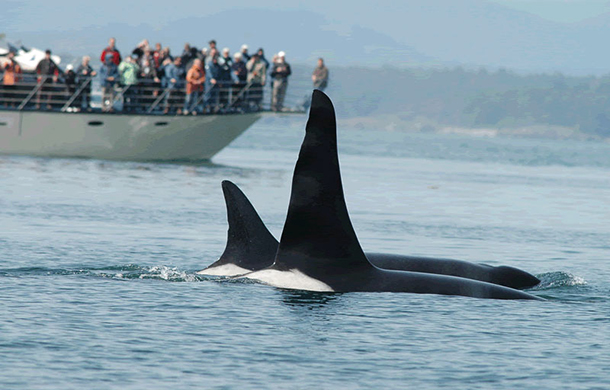
J2 on the left with her son, J1. Adult male orcas have a distinctively tall, straight dorsal fin, compared with the shorter curved dorsal of a female. (Photo: Center for Whale Research)
BALCOMB: Well, thank you for having me.
CURWOOD: And I'm so sorry to hear about the loss of this majestic creature.
BALCOMB: It's a blow to us all. She was an icon of not only her pod and the population, but of the northwest.
CURWOOD: So, how sure are you that she's really gone? Maybe she's on a walkabout someplace? You know, there's a big ocean out there.
BALCOMB: Yeah, we wish. We've crossed our fingers for three months, but when we have a half a dozen encounters with the family, and the individual we seek is not there, they're presumed deceased, and then by the next year we're confirmed deceased. She's gone. We know it. Her time was up.
CURWOOD: And she wouldn't have left her family.
BALCOMB: No, no, that's one thing they don't do. All the whales stay together in a family group throughout their life.
CURWOOD: Ken, you've been studying J2 for decades. Tell us what it's been like to watch her in the waters there of Puget Sound.
BALCOMB: Well, it's been amazing. When we began the study in 1976, we were following in the giant footsteps of Dr. Mike Bigg, who started at the north end of Vancouver Island, found a pod of whales, called them “A” pod and numbered them within the group A1,2,3 and B and C and D and so on as he came down the island. When he came to the south end adjoining Puget Sound, he was at J, K and L in the alphabet and that's where we've been. One of the whales that was adult, she was leading the pod, and that was J2, Granny.
CURWOOD: So, tell me about her group. There are different pods, of course, with these whales.
BALCOMB: Well, I first saw Granny in 1976 on April 16. The pod was spread out coming into Puget Sound through Admiralty Inlet. I had previously seen K and L pods out in the Strait of Juan de Fuca, and I called up Dr. Bigg and excitedly told him, "Hey, we found a new group of whales." And he dampened my excitement right away by saying, "Oh, you must have found J pod," and he started describing every whale in the pod over the phone to me, while I was looking at the pictures that I took, and it was precise. We had this female that was always accompanying this very tall fin male that had a wavy back margin to his fin. He was called J1, and she was the one that was always right next to him. She had a little nick in her fin, and she was J2. After years of study, we surmised, based upon from what we saw from the other whales, that she was his mother because we have observed now that the offspring never leave their mother in their lifetime.
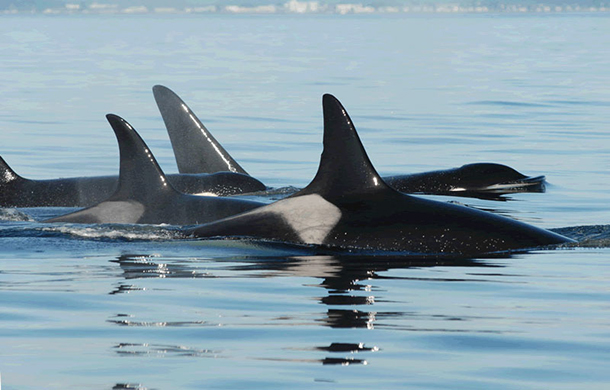
J2 with her pod in 2011 (Photo: Center for Whale Research)
CURWOOD: How did researchers know approximately how old J2, Granny might have been?
BALCOMB: Well, we took the estimated birth date of J1 as 1951, based upon photographs that we had of him already mature in 1967 captures. See, all these whales in the southern resident killer whale community had been captured numerous times, from the early or mid-1960s to the mid-1970s, and the babies had been removed each time and sold to aquaria throughout the world. So, we had two things going on. We had photographs of what were adults and uwere nsuitable for transport, and we had a whole cohort age of young whales that were removed. So, we had a skewed population structure when we began the study in 1976.
Anyway, back to J1, birthdate '51, and at the time no other relatives that could be identified as being subsequent babies of Grandma, so we then made the assumption that he was her last offspring. In which case, females like female humans have a menopause at about age 40 they stop reproducing, but they'll still have a long post reproductive life, babysitting, leading, teaching the other whales what they've learned in their lifetime. At least she was born before 1941 and probably 1911.
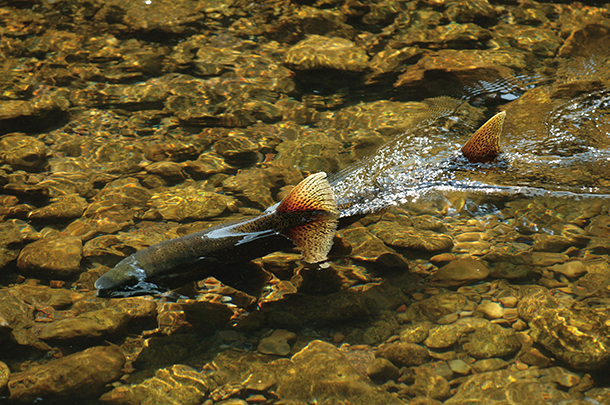
Chinook salmon, a key prey of southern resident killer whales, returning to their spawning grounds (Photo: Lynn Ketchum / Oregon State University, Flickr CC BY-SA 2.0)
CURWOOD: So, do a little math here. If she was born in 1911, she died 105 years later. So, Granny would've seen the whole change in the oceans in her lifetime and experienced a fair amount of heartbreak if she was captured repeatedly and the children were taken away.
BALCOMB: Yeah, if she could tell us the story of her life, people should listen very carefully. She's seen, basically, a marine ecosystem degraded to the point where now it's threatening the entire population. It's threatening the life of the ocean, really.
CURWOOD: You say that this pod of killer whales is an urban pod. Why do you say that?
BALCOMB: Well, these whales come into what we call the Salish Sea. We now call it Salish Sea, but it was previously called Puget Sound and the Strait of Juan de Fuca and Georgia Strait, the inland waters of Washington and southern British Columbia. And there were, at the time we began this study, about 1.9 million Chinook salmon caught in this area, averaged well over 20 pounds each year by humans. So, there are a lot of fish around here, and they came here for the fish. The whales came for the fish, and they in fact had specialized on these fish for most of their recent evolution since the Ice Ages. They didn't come to see the people or the Seattle Space Needle or the mountains around here. They came to eat the fish year-round, but as the fish populations declined due to over-harvest, damming of the rivers, logging practices, and development of the shorelines that were areas that fish required for their growth and feeding before they headed to the big ocean for three or four years before coming back to spawn, dams were the big killer. Once the dams were put in on the rivers, the fish couldn't return to the river to spawn, and we've seen, I mean right now, 22,000 King Salmon compared to 1.9 million is a more than quantum decrease.
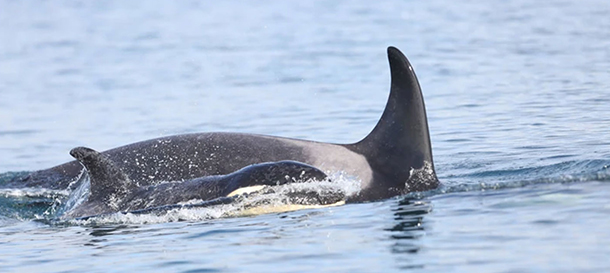
On October 23rd, 2016 whale observers Mark and Hanna Malleson received a report that ten-month-old orca calf J54 looked to be in poor condition, with “raked up and peeling” skin and “a major depression behind his blowhole”. Days later researchers announced his mother had probably died. Above, fellow pod member J46 supports the ailing J54. (Photo: Mark Malleson)
CURWOOD: So, what was Granny's role, what was J2’s role in her pod and in the broader population of the southern resident Killer whales?
BALCOMB: She learned from her mom and grandma what rivers and what seasons had returning biomasses of Chinook salmon. And so, they would go around...It's like berry-picking season, go around to every area that had abundant fish supplies. She had to know where these spots were, and she taught all of her offspring and the others in the pod, “Well let's go over there.” She’d be the leader.
CURWOOD: So, what do you think is going to happen now to this J pod, now that Granny’s gone?
BALCOMB: Well, we've already seen it happen in other pods. The K and L pods, they've lost matriarchs, older females, and we get a fragmentation of the social structure. Now they're traveling in just their little family groups, you know, five or six whales. When you have a few thousand fish over tens of thousands of square miles of ocean, you have to be in small hunting groups to find anything. You can't all be in one place. So, we see this fragmentation as a result of prey resource depletion and social fragmentation. Basically, your leader is gone. Now what do you do? She had daughters...well, actually her daughter has died and her son has died, but her granddaughter is still alive. They are the presumed next leaders, but the problem has been that, first of all, we removed a whole cohort of whales that should have grown up and been leaders now, and we're experiencing food resource problems that is making… the miscarriage rate of these whales, on the order of 75 percent of the conceptions miscarry. They're aborted. It leads us to a conclusion that there is an issue in reproduction here, a real problem.

Whale watchers at Haro Strait, late August 2016 (Photo: Ken Balcomb)
CURWOOD: So, what's your best guess as to why the Orcas are losing baby whales. We're talking about pollution? We're talking about the lack of salmon? What's going on here?
BALCOMB: Granny was born before any of these industrial contaminants, pollutants that bioaccumulate in the tissues, were even developed, and we've subsequently found that a lot of these things like PCPs, PBDEs, DDTs, affect life functions, and a lot of them are hormone mimics. They're you know like, “Little fetus start growing a fin or you start breathing now or developing a nervous system or reproductive system.” What is going on is you have these whales going along eating contaminated food, metabolizing the energy in that food and storing it in their blubber fat. As long as there's lots of fish, they're only getting the contamination that's available in that fish that they eat right now, but when they don't have fish they go back to this blubber layer and metabolize that fat which has accumulated over thousands and thousands of fish, to the point where it's hyper-toxic.
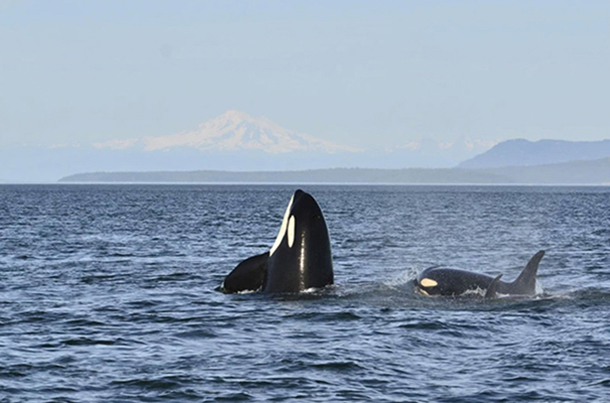
Another member of the J pod, J22, “spy hops” in front of Mt. Baker in Haro Strait (Photo: Jeff Hogan)
We know that if humans were exposed to those levels of toxins, they would have birth defects, birthing issues in general, measurable decrease in brain size and in brain function, measurable decrease in reproductive function even to the point of zero reproductive abilities. You know, we see it in people. We see it in mice. We see it in seals. And we see it in whales. It affects them, and it affects their offspring.
We have about 10 more years of reproductive viability in this population to turn around the issue of whether or not we're going to feed them, and whether or not we're going to feed them is dependent upon, are we going to do something about big obstacles to fish reproduction like the dams. If the fish can't swim up the river to spawn, we're not going to have fish in the future.
CURWOOD: So, Ken, one of the things you first notice when you go to your website, the Center for Whale Research, are all the whale obituaries. It looks like the J pod of Orcas in Puget Sound lost several family members in just the past few months. What you think is going on?

Granny (J2) breaching, or leaping out of the water, in 1998 (Photo: Center for Whale Research)
BALCOMB: Well, yeah, they've lost five individuals here in the past few months, and they were not only the leader individual but two of the reproductive mothers and their offspring. What do I think is going on? I think we're seeing the end of the tunnel here.
We've been complaining for years to the government and trying to educate the public about the need to feed these whales. And the least expensive and most available food would be wild Chinook salmon that were allowed to return to the rivers and spawn and produce food for humans, whales, the whole ecosystem. The dams that are in question are on the Columbia River, which used to provide 12 million Chinook salmon a year, and then that production was stopped by damming the rivers and there are four of them right now on the Snake River system that deny access to what had been a million to two million adult Chinook a year coming up to spawn.
CURWOOD: So, you worked with Granny, J2, for some four decades. How do you feel about her loss?
BALCOMB: I couldn't talk about it for a couple days. You're the first person I've talked to about this since we've made our announcement. I've had several people in media plead with me to get on there and say it like it is. It really hurt.
What is actually distressing me more right now is that her loss may be irrelevant to our human society. I mean, we will have a little emotional tag to it, but we didn't as a society accept the factual observations. Truth is almost irrelevant. Observed facts are almost irrelevant. You get elected or make money or you do whatever on the basis of your tweets and Twitters and unverifiable facts. If you can sway this thing this way, you do, if it is to your benefit. I thought that science and basic observable facts were going to be important, and that's pretty distressing for me to see, along with the passing of Granny, to see that that's what we're going to have to deal with in the future. We're in a bind here, if we're not to pay attention to observed facts. They were the top of a very, very productive ecosystem that we're seeing go away before our very eyes, and if we don't look at these “canaries in our coal mine”, then we're playing stupid.
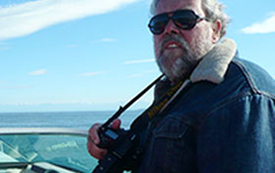
Ken Balcomb has been studying Granny (J2) for more than four decades (Photo: Center for Whale Research)
CURWOOD: You say that these Orcas really live with their families forever. To what extent do you think they love each other, care about each other?
BALCOMB: To a great extent. The scientists will give it a term called epimeletic behavior or caregiving. They will carry a dead infant on their back for a week. Or they will assist an injured podmate, support it and two whales will be on either side of it and hold it up so it can breathe. They're obligated to keep moving. It's like the Marines, you know? You don't leave them behind, you carry them with you. Ultimately, you have to let them go, like we'll have to let Granny go, and like she's let many others go in her lifetime.
CURWOOD: Ken Balcomb is the Executive Director and Senior Scientist of the Center for Whale Research in Friday Harbor, that's in Puget Sound, Washington. Thanks so much, Sir, for taking the time with us today.
BALCOMB: Thank you. It's been my pleasure.
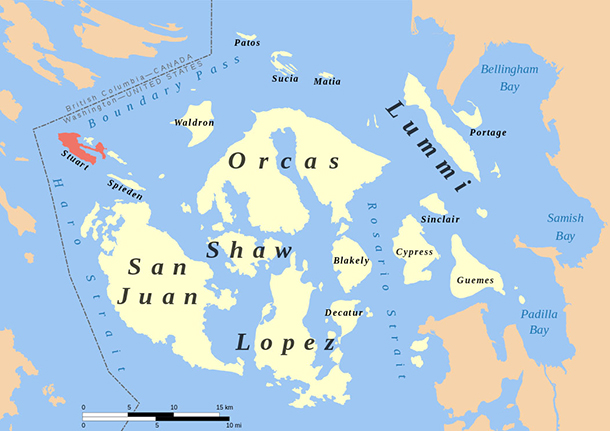
Ken Balcomb recorded sounds of orcas off the coast of Stuart Island (shown in red above) in the Salish Sea in 1995. (Photo: Evan Derickson, Wikimedia Commons CC BY-SA 4.0)
[MUSIC: Noah and The Whale “Instrumental II” from The First Days of Spring, 2009 Mercury Record]
[ORCAS CALLING]
CURWOOD: We leave you this week among those very Orcas in Puget Sound.
[ORCAS CHATTERING AND CALLING]
At about 11 p.m. one night in 1995, Ken Balcomb came across J, K and L pods gathered together south of Stuart Island.
[ORCA CHATTER]
Ken writes that there were plenty of salmon, and the gathering seemed very social with whales chattering to each other, as if they were having a party.
[ORCAS CALLING]
In the pitch darkness, he recorded this with a hydrophone, as some 98 whales blew and spouted around his boat.
[ORCAS CALLING]
Links
“J2: In Memoriam”, by Ken Balcomb
“Goodbye Granny,” by Erin Heydenreich of the Center for Whale Research
Seattle Times: “Sad drama in Puget Sound: Another orca dies, dim hopes for her calf”
Video of J and L pods breaching in the waters off British Columbia
New study provides one theory for why orcas go through menopause
Living on Earth wants to hear from you!
Living on Earth
62 Calef Highway, Suite 212
Lee, NH 03861
Telephone: 617-287-4121
E-mail: comments@loe.org
Newsletter [Click here]
Donate to Living on Earth!
Living on Earth is an independent media program and relies entirely on contributions from listeners and institutions supporting public service. Please donate now to preserve an independent environmental voice.
NewsletterLiving on Earth offers a weekly delivery of the show's rundown to your mailbox. Sign up for our newsletter today!
 Sailors For The Sea: Be the change you want to sea.
Sailors For The Sea: Be the change you want to sea.
 The Grantham Foundation for the Protection of the Environment: Committed to protecting and improving the health of the global environment.
The Grantham Foundation for the Protection of the Environment: Committed to protecting and improving the health of the global environment.
 Contribute to Living on Earth and receive, as our gift to you, an archival print of one of Mark Seth Lender's extraordinary wildlife photographs. Follow the link to see Mark's current collection of photographs.
Contribute to Living on Earth and receive, as our gift to you, an archival print of one of Mark Seth Lender's extraordinary wildlife photographs. Follow the link to see Mark's current collection of photographs.
 Buy a signed copy of Mark Seth Lender's book Smeagull the Seagull & support Living on Earth
Buy a signed copy of Mark Seth Lender's book Smeagull the Seagull & support Living on Earth

